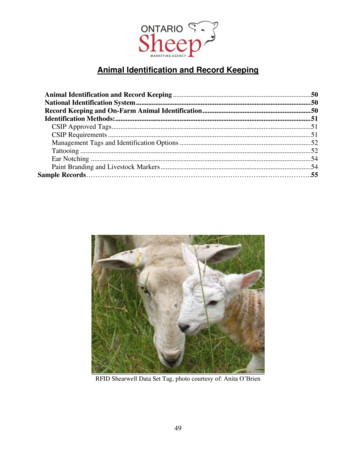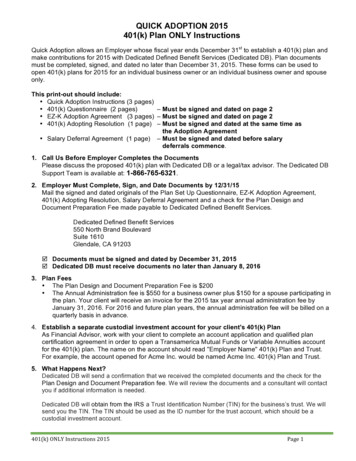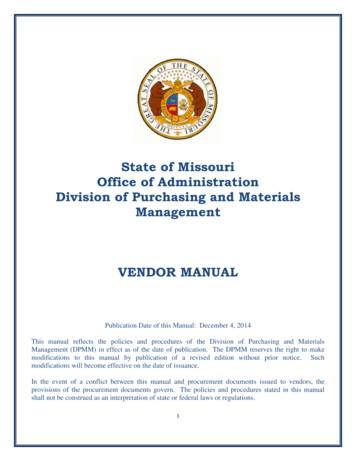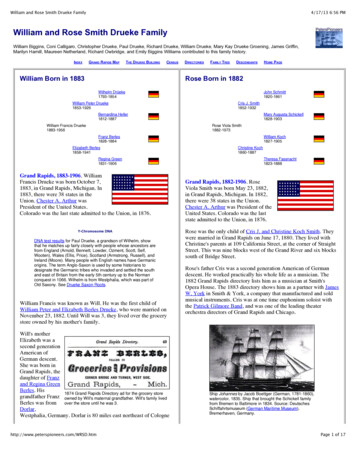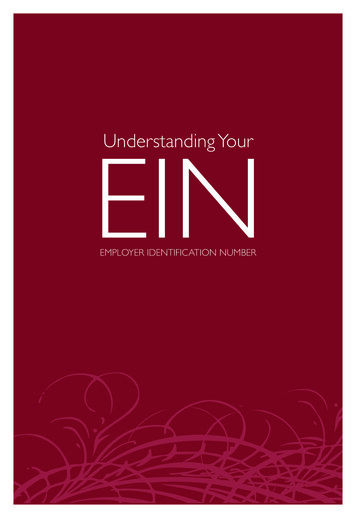
Transcription
Understanding YourEINEmployer Identification Number
Understanding Your EINEMPLOYER IDENTIFICATION NUMBERThis publication provides general information on Employer Identification Numbers(EINs).The topics included are: What is an EIN Information by type of business entity When you need a new EIN How to apply for an EIN How to complete Form SS-4 Where to apply for an EIN How to avoid common problems1
Table of ContentsI What is an EIN?.3II Special Rules Regarding Entity ClassificationElections.3III Information by Type of Business Entity.4A. Sole Proprietor.4B. Corporation.5C. Partnership.7D. Estate. . . . .9E. Trust.10F. Employee Plans.12G. Exempt Organization.13H. Limited Liability Companies.16IV Employment and Excise Taxes.17A. Employment Taxes. 17B. Excise Taxes.18V How to Apply for an EIN .19VI How to Complete Form SS-4 .20A. Sole Proprietor. 21B. Corporation .23C. Partnership. 25D. Trust. .26E. GNMA Pools . . .28(Governmental National Mortgage Association)F. Estate (Decedent).29G. Plan Administrators.30H. Employee Plans. 31I. Exempt Organization.32J. Bankruptcy (Individual) .34K. Bankruptcy (Corporation or Partnership).35L. Electronic Federal Tax Payment System (EFTPS).35VII Where to Apply for an EIN (Mail and Fax).36VIII Avoiding Common EIN Problems . .372
I. What is an EIN?An Employer Identification Number (EIN) is a nine-digit number that IRSassigns in the following format: XX-XXXXXXX. It is used to identify thetax accounts of employers and certain others who have no employees.However, for employee plans an alpha (for example, P) or the plannumber (e.g., 003) may follow the EIN. The IRS uses the number toidentify taxpayers that are required to file various business tax returns.EINs are used by employers, sole proprietors, corporations,partnerships, non-profit associations, trusts, estates of decedents,government agencies, certain individuals, and other business entities.Use your EIN on all of the items that you send to the IRS and the SocialSecurity Administration (SSA).Caution: An EIN is for use in connection with your business activitiesonly. Do not use your EIN in place of your social security number (SSN).You should have only one EIN for the same business entity. If you havemore than one EIN and are not sure which one to use, call the Businessand Specialty Tax Line at 1-800-829-4933 (TTY/TDD users can call 1800-829-4059). Give the numbers that you have, the name and addressto which each was assigned, and the address of your main place ofbusiness. The IRS will tell you which number to use.If you do not have your EIN by the time your return is due, write “AppliedFor” and the date that you applied for it in the space shown for thenumber.II. Special Rules Regarding Entity ClassificationElectionsThere are special rules and procedures for classification elections madeon Form 8832, Entity Classification Election. Those rules and proceduresare not reflected in this publication. The results explained in thispublication may be different when an entity classification election isinvolved. See the instructions for Form 8832 for further informationregarding entity classification elections.3
III. Information by Type of Business EntityThis section contains the following information: Definitions of various entity types Which forms each entity type may file When you need a new EIN When you don’t need a new EINA. Sole ProprietorshipDefinition:A sole proprietorship is an unincorporated business that is owned by oneindividual. It is the simplest form of business organization to start andmaintain. The business has no existence apart from you, the owner. Itsliabilities are your personal liabilities and you undertake the risks of thebusiness for all assets owned, whether or not used in the business.Include the income and expenses of the business on your own taxreturn. For more information on sole proprietorships, see Publication334, Tax Guide for Small Businesses. If you are a farmer, seePublication 225, Farmer’s Tax Guide.Form(s):Business profits or losses of a sole proprietorship are reported onSchedule C, Schedule C-EZ, or Schedule F of Form 1040, U.S.Individual Income Tax Return. A sole proprietor may also be required tofile other returns (such as employment or excise tax returns).You will need a new EIN if any of the following are true: You file bankruptcy under Chapter 7 (liquidation) or Chapter 11(reorganization) of the Bankruptcy Code You incorporate You are a sole proprietor and take in partners and operate as apartnership You are establishing a pension, profit sharing, or retirement planYou do not need a new EIN if any of the following are true: You change the name of your business4
You change your location or add locations (stores, plants, enterprisesor branches of the entity) You operate multiple businesses (including stores, plants, enterprisesor branches of the entity)NOTE: If you are a sole proprietor who conducts business as a limitedliability company (LLC), you do not need a separate EIN for the LLC. Alimited liability company is an entity formed under state law by filingarticles of organization as an LLC. An LLC owned by one individual isautomatically treated as a sole proprietorship for federal tax purposes(referred to as an entity to be disregarded as separate from its owner).Report the business activities of the LLC on your Form 1040 using aSchedule C, Schedule C-EZ or Schedule F.B. CorporationDefinition:A corporation is defined as a legal entity or structure created under theauthority of the laws of a state consisting of a person or group of personswho become shareholders. The entity's existence is considered separateand distinct from that of its members. Since a corporation is an entity inits own right, it is liable for its own debts and obligations. In forming acorporation, prospective shareholders transfer money, property, or both,for the corporation’s capital stock.The following businesses formed after 1996 are taxed ascorporations: A business formed under a federal or state law that refers to it as acorporation, body corporate, or body politic A business formed under a state law that refers to it as a joint-stockcompany or joint-stock association An insurance company Certain banks A business wholly owned by a state or local government A business specifically required to be taxed as a corporation by theInternal Revenue Code Certain foreign businesses Any other business that elects to be taxed as a corporation, forexample, a limited liability company (LLC) by filing Form 8832, EntityClassification Election. For more information, see the instructions for5
Form 8832.Form(s):Corporations usually file a Form 1120 series return plus other returnsthat apply (such as employment or excise tax returns).The Form 1120 series returns are as follows: Form 1120, U.S. Corporation Income Tax Return Form 1120-A, U.S. Corporation Short-Form Income Tax Return Form 1120-C, U.S. Income Tax Return for Cooperative Associations Form 1120-F, U.S. Income Tax Return of a Foreign Corporation Form 1120-FSC, U.S. Income Tax Return of a Foreign SalesCorporation Form 1120-H, U.S. Income Tax Return for Homeowners Associations Form 1120-L, U.S. Life Insurance Company Income Tax Return Form 1120-ND, Return for Nuclear Decommissioning Funds andCertain Related Persons Form 1120-PC, U.S. Property and Casualty Insurance CompanyIncome Tax Return Form 1120-POL, U.S. Income Tax Return for Certain PoliticalOrganizations Form 1120-REIT, U.S .Income Tax Return for Real Estate InvestmentTrusts Form 1120-RIC, U.S. Income Tax Return for Regulated InvestmentCompanies Form 1120S, U.S. Income Tax Return for an S Corporation Form 1120-SF, U.S. Income Tax Return for Designated SettlementFunds (Under section 468B)You will need a new EIN if any of the following are true: You are a subsidiary of a corporation and currently use the parent’scorporate EIN You become a subsidiary of a corporation The corporation becomes a partnership or a sole proprietorship You create a new corporation after a statutory merger You receive a new corporate charter6
You do not need a new EIN if any of the following are true: You are a division of a corporation After a corporate merger, the surviving corporation uses its existing EIN A corporation declares bankruptcy. However, if a liquidating trust isestablished for a corporation that is in bankruptcy, an EIN for that trustis required. See Treasury Reg. § 301.7701-4(d) Your business name changes You change your location or add locations (stores, plants, enterprisesor branches) You elect to be taxed as an S Corporation by filing Form 2553 After a corporate reorganization, you only change identity, form, orplace of organization The corporation is sold and the assets, liabilities and charters areobtained by the buyerC. PartnershipDefinition:A partnership is the relationship existing between two or more personswho join together to carry on a trade or business. Each partnercontributes money, property, labor or skill, and expects to share in theprofits and losses of the business.The term ‘partnership’ includes a limited partnership, syndicate, group,pool, joint venture, or other unincorporated organization, through or bywhich any business, financial operation, or venture is carried on.An unincorporated organization with two or more members is generallyclassified as a partnership for federal tax purposes if its members carryon a trade, business, financial operation, or venture and divide its profits.However, a joint undertaking merely to share expenses is not apartnership. For example, co-ownership of property maintained andrented or leased is not a partnership unless the co-owners provideservices to the tenants.Husband and Wife Businesses – Sole Proprietorship orPartnership?Many small businesses are operated by husband and wife, withoutincorporating or creating a formal partnership agreement. A husband andwife business may be a partnership, whether or not a formal partnership7
agreement is made. However, please see the information belowregarding new legislation designed to reduce taxpayer burden forhusband and wife businesses.HR 2206, Public Law 110-28, Small Business and Work Opportunity TaxAct of 2007, Provision No. 8215 provides that for tax years beginningafter 12/31/2006, a qualified joint venture conducted by a husband andwife who file a joint return is not rated as a partnership for federal taxpurposes.If a husband and wife materially participate as the only members of ajointly owned and operated business, and file a joint federal income taxreturn (Form 1040), they can elect for the business to be taxed as aqualified joint venture instead of a partnership. To make the election, allitems of income, gain, loss, deduction, and credit must be dividedbetween the spouses, in accordance with each spouse’s interests in theventure, and reported on separate Schedules C or F as sole proprietors.Spouses who meet these qualifications and require EINs should submitseparate Forms SS-4 as sole proprietors. Do not apply for a joint EIN asa “Qualified Joint Venture”.NOTE: If your spouse is your employee, not your partner, you must paySocial Security and Medicare taxes for him or her.Form(s):A partnership files Form 1065, U.S. Partnership Return of Income, plusother returns that apply (such as employment or excise tax returns).You will need a new EIN if any of the following are true: You incorporate One partner takes over and operates as a sole proprietorship The partnership is terminated (no part of any business, financialoperation, or venture of the partnership continues to be carried on byany of its partners in a partnership) and a new partnership is begunYou do not need a new EIN if any of the following are true: The partnership declares bankruptcy. However, if a liquidating trust isestablished for a partnership that is in bankruptcy, an EIN for that trustis required. See Treasury Reg. § 301.7701-4(d) The partnership name changes8
The location of the partnership changes or new locations are added. The partnership terminates under IRC Section 708(b)(1)(B). Apartnership shall be considered terminated if within a 12-month periodthere is a sale or exchange of at least 50% of the total interest inpartnership capital and profits to another partner. If the purchaser andremaining partners immediately contribute the properties to a newpartnership, they can retain the old partnership EIN.D. EstateDefinitions:Estate: An estate is a legal entity created as the result of a person’sdeath. The decedent’s estate is a separate legal entity for federal taxpurposes. An estate consists of real and/or personal property of thedeceased person. The estate pays any debts owed by the decedent andthen distributes the balance of the estate’s assets to the beneficiaries ofthe estate. The estate exists until the final distribution of the assets ismade to the heirs and other beneficiaries.Fiduciary: A fiduciary is any person acting in a fiduciary capacity for anyother person. A fiduciary for a decedent’s estate can be an executor,administrator, personal representative, or person in possession ofproperty of a decedent’s estate. The primary duties of the fiduciary are tocollect all the decedent’s assets, pay the creditors, and distribute theremaining assets to the heirs or other beneficiaries.Form(s): Estates file either Form 706, United States Estate (and GenerationSkipping Transfer) Tax Return or Form 1041, U.S. Fiduciary Return of Income, plus other returns thatapply (such as employment or excise tax returns).You will need a new EIN if any of the following are true: A trust is created with estate funds. Such a trust is not simply acontinuation of the estate. You represent an estate that operates a business after the owner’sdeath.9
You do not need a new EIN if any of the following are true: The administrator, personal representative, or executor changes. The beneficiaries of an estate change.E. TrustDefinitionsTrust: A trust is an arrangement through which trustees take title toproperty for the purpose of protecting or conserving it for thebeneficiaries under the ordinary rules applied in chancery or probatecourts. A trust is a legal entity created under state law and taxed underfederal law. A trust may be created during an individual’s lifetime (intervivos) or at the time of his or her death under a will (testamentary).Trusts include guardianships, custodianships, conservatorships,receiverships, escrow accounts, Ginnie Mae (GNMA) and Fannie Mae(FNMA) pools.Fiduciary/Trustee: A fiduciary is an individual or organization chargedwith the duty to act for the benefit of another. A trustee is a fiduciary. Thetrustee obtains legal title to the trust assets and is required to administerthe trust on behalf of the beneficiaries according to the express termsand provisions of the trust agreement.Beneficiary: A beneficiary is a person designated as a recipient offunds or other property under a trust or an estate.Grantor: The grantor (also known as trustor, settlor, or creator) is thecreator of the trust relationship and is generally the owner of the assetsinitially contributed to the trust. The grantor generally establishes in thetrust instrument the terms and provisions of the trust relationshipbetween the grantor, the trustee, and the beneficiary. The grantor mayretain control over all or a portion of the trust, which may result in thegrantor being subject to tax on the income from that portion of the trust.Revocable/Irrevocable Trust: An irrevocable trust is a trust, which, byits terms, cannot be modified, amended, or revoked. For tax purposes anirrevocable trust can be treated as a simple, complex, or grantor trust,depending on the powers listed in the trust instrument. A revocable trustmay be revoked and is considered a grantor trust (IRC § 676). State lawand the trust instrument establish whether a trust is revocable orirrevocable. If the trust instrument is silent on revocability, then most10
states consider the trust revocable.Living Trust: A living person creates an inter vivos trust during thatperson's lifetime. An inter vivos trust can be established as revocable orirrevocable. An inter vivos trust can be a simple, complex, or grantor trustdepending on the trust instrument.Testamentary Trust: A testamentary trust is created by a will, whichbegins its existence upon the death of the person making the will, whenproperty is transferred from the decedent's estate. Testamentary trustsare generally simple or complex trusts. A testamentary trust isirrevocable by definition, as it comes into being at the death of thegrantor. A “trust under the will’ is the same as a testamentary trust.Conservatorship: A trust, not an estate, which is usually set up for anincompetent person.Guardianship/Custodianship: A trust usually set up for a minor.Form(s):Form 1041 U.S. Fiduciary Return of Income, plus other returns that apply(such as employment tax returns).You will need a new EIN if any of the following are true: A trust changes to an estate. A living (inter vivos) trust changes to a testamentary trust. A living trust terminates by distributing its property to a residual trust. The revocable trust changes to an irrevocable trustYou do not need a new EIN if any of the following are true: The trustee changes. The grantor or beneficiary changes his or her name or address.NOTE: Separate EINs are needed if one person is the grantor/maker ofmultiple trusts. For example, if you have a trust for each of yourgrandchildren, each trust must have a separate EIN and file a separatetax return. However, a single trust with several beneficiaries requiresonly one EIN.11
F. Employee PlansDefinitions:Employee Benefit Plan: An employee benefit plan is a permanentarrangement under which an employer provides retirement or healthbenefits for employees. Some of these include: cafeteria plans, definedbenefit plans, and defined contribution plans. The employer/sponsorand/or the plan administrator file the applicable returns.Plan Sponsor: The plan sponsor is the entity that establishes andmaintains a benefits plan. The plan sponsor is usually an employer, butmay also be an employee organization created for the purpose ofoffering benefits. If the plan is a "multi-employer plan," the committee orother entity that established the plan is considered the plan sponsor.Plan Administrator: The plan administrator is the person or companywho handles day-to-day details of operating a health benefit or pensionplan, such as processing claims for benefits, employer and employeecontributions, record-keeping, and reports. The administrator is usuallyidentified in the plan creation documents.NOTE: If you are reporting withholding on pension distributions, be sureto be consistent in using the same name and EIN for all reporting anddepositing of taxes, i.e. Forms 945, 1099-R, and 8109/EFTPS). FilingForm 945 with an incorrect name or EIN or failure to use the same nameand EIN in all reporting and depositing of taxes may result in penaltiesand delays in processing your return.Form(s):Employee plans usually file Form 5500 series returns plus other returnsthat apply (such as employment or excise taxes). The major employeeplan forms are listed below.NOTE: If the employer/sponsor entity already has an EIN, use thatnumber on all Form 5500 series returns. Form 5500, Annual Return/Report of Employee Benefit Plan (with 100or more participants) Form 5500-C/R, Return/Report of Employee Benefit Plan (with fewerthan 100 participants)12
Form 5500EZ, Annual Return of One-Participant (Owners and TheirSpouses) Pension Benefit Plan Form 1099-R, Distributions From Pensions, Annuities, Retirement orProfit-Sharing Plans, IRAs, Insurance Contracts, etc. Form 5304-SIMPLE, Savings Incentive Match Plan for Employees ofSmall Employers (SIMPLE) (Not Subject to the Designated FinancialInstitution Rules) Form 5305-SEP, Simplified Employee Pension-Individual RetirementAccounts Contribution Agreement Form 5305A-SEP, Salary Reduction and Other Elective SimplifiedEmployee Pension-Individual Retirement Accounts ContributionAgreement Form 5305-SIMPLE, Savings Incentive Match Plan for Employees ofSmall Employers (SIMPLE) (for Use With a Designated FinancialInstitution) Form 5329, Additional Taxes Attributable to IRAs, Other QualifiedRetirement Plans, Annuities, Modified Endowment Contracts, andMSAs Form 5330, Return of Excise Taxes Related to Employee Benefit PlansNOTE: For more information on employee plans visit the RetirementPlans Community located on the IRS website at www.irs.gov.G. Exempt OrganizationsDefinitions:Tax Exempt Organization: A non-profit organization granted anexemption from certain taxes by the Internal Revenue Service underSection 501 of the Internal Revenue Code.IRC Section 501(c)(3) Organization: This is an organization that isorganized and operated exclusively for one or more of the followingpurposes: charitable, religious, educational, scientific, literary, testing forpublic safety, fostering national or international amateur sportscompetition (but only if none of its activities involves providing athleticfacilities or equipment), or the prevention of cruelty to animals. Toqualify, the organization must be a corporation, community chest, fund,or foundation. A trust is a fund or foundation and will qualify. However,an individual or a partnership will not qualify.Contributions to domestic organizations, except organizations testing forpublic safety, are generally deductible as charitable contributions on thedonor’s federal income tax return.13
See Publication 557 for a chart listing many other categories of exemptorganizations.Organizations seeking formal recognition of their exempt status mustgenerally file one of the applications listed below with the InternalRevenue Service and must pay the required user fee. Requests forexemption under subsections other than 501(c)(3) must include Form8718, User Fee for Exempt Organization Determination Letter Request.Requests should be sent to the address shown on Form 1023 and onForm 8718. To decide which application form listed below is needed foryour organization, refer to Publication 557, Tax-Exempt Status for YourOrganization.Form 1023, Application for Recognition of Exemption Under Section501(c)(3) of the Internal Revenue CodeForm 1024, Application for Recognition of Exemption Under Section501(a) for Determination Under Section 120 of the Internal RevenueCodeNOTE: All nonprofit organizations must apply for an EIN before filing forexempt status.All publications and forms mentioned above are available for downloadfrom the IRS website, www.irs.gov, or by calling our toll-free number 1800-TAX-FORM.Organizations not required to apply for formal tax exempt status:Some organizations are treated as tax exempt under IRC Section501(c)(3) without being required to file Form 1023, provided they areorganized and operated appropriately. These include: Churches, interchurch organizations of local units of a church,conventions or associations of churches, or integrated auxiliaries of achurch, such as a men’s or women’s organization, religious school,mission society, or youth group. Any organization (other than a private foundation) normally havingannual gross receipts of not more than 5,000.Private Foundation vs. Public Charity: Most organizations that areexempt from income tax under IRC Section 501(c)(3) are presumed tobe private foundations unless they notify the Internal Revenue Servicewithin a specified period of time that they are not. In effect, the definition14
divides organizations into two classes, namely private foundations andpublic charities. There is an excise tax on the net investment income ofmost domestic private foundations. In addition, there are several otherrules that apply.Group Exemption Letter: A group exemption letter is a ruling ordetermination letter issued to a central organization recognizing on agroup basis the exemption of subordinate organizations on whose behalfthe central organization has applied for recognition of exemption. Acentral organization is an organization that has one or more subordinatesunder its control. A subordinate organization is a chapter, local, post, orunit of a central organization.Public Disclosure of Forms 990: Exempt organization Forms 990 arerequired to be made available to the public. Procedures for obtaining thisinformation are found in Publication 557, Tax-Exempt Status for YourOrganization, and Form 4506A, Request for Public Inspection or Copy ofExempt or Political Organization.Unrelated Business Income: Even though an organization isrecognized as tax-exempt, it still may be liable for tax on its unrelatedbusiness income. Unrelated business income is income from a trade orbusiness, regularly carried on, that is not substantially related to thecharitable, educational, or other purpose that is the basis for theorganization’s exemption.Backup Withholding: If your only reason for filing Form 990-T is toclaim a refund of backup withholding, complete the required information,as discussed in Form 990-T instructions, and attach a copy of the Form1099 showing the withholding.Form(s)Exempt organizations usually file a Form 990 series return plus otherreturns that apply (such as employment or excise tax returns). Theexempt organization forms are listed below: Form 990, Return of Organizations Exempt From Income Tax Form 990-EZ, Short Form Return of Organization Exempt From IncomeTax Form 990-BL, Information and Initial Excise Tax Return for Black LungBenefit Trusts and Certain Related Persons Form 990-PF, Return of Private Foundation or Section 4947(a)(1)Charitable Trusts Treated as a Private Foundation15
Form 990-T, Exempt Organization Business Income Tax Return Form 4720, Return of Certain Excise Taxes on Charities and OtherPersons under Chapters 41 and 42 of the Internal Revenue Code Form 5578, Annual Certification of Racial Nondiscrimination for aPrivate School Exempt from Federal Income TaxAnnual information returns: Except for private foundations, whichmust file Form 990-PF annually regardless of gross receipts, an exemptorganization that normally has 25,000 or more in gross receipts mustfile an exempt organization information return Form 990, Return ofOrganization Exempt from Income Tax, whether or not the organizationhas formal tax exempt status.H. Limited Liability Company (LLC)Definition: A limited liability company (LLC) is an entity formed understate or foreign law by filing articles of organization as an LLC. Unlike apartnership, none of the members of an LLC are personally liable for itsdebts.LLC Tax Classification: Treas. Reg. Section 301.7701-3 providesguidance on classification for limited liability companies. Generally, if thebusiness is an unincorporated business entity, and there are two or moreowners, the entity can choose to be a partnership or a corporation. If anunincorporated business entity has only one owner, it can either elect tobe a corporation or the entity can be disregarded. If an individual owns adisregarded entity, it is treated as a sole proprietorship. If a corporationowns a disregarded entity, it is treated as a division or branch of thecorporation. See Form 8832, Entity Classification Election, for moredetails.NOTE: While a single member entity, that does not elect corporatestatus, will default to a disregarded status for some federal tax purposes,they will not be disregarded for all federal tax purposes. For federalemployment taxes (after January 1, 2009) and certain excise taxes (afterJanuary 1, 2008) they will be treated as separate entities.Single Member LLC:A single member LLC generally has the following choices:(1) File Form 8832 to be taxed as a corporation(2) If qualified, file Form 2553, Election by a Small Business Corporation16
(Under Section 1362 of the Internal Revenue Code), to be taxed as an Scorporation(3) Be taxed (by default) as a disregarded entity If the single member is an individual, the LLC will be taxed as a soleproprietorship If the single member is a business entity, the LLC will be taxed as adivision of the corporationMultiple Member LLC:A multiple member LLC generally has the following choices:(1) File Form 8832 to be taxed as a corporation(2) If qualified, file Form 2553 to be taxed as an S-Corporation(3) Be taxed (by default) as a partnershipNote: A husband and wife, who are owners of an LLC, and share in theprofits of such, can file as a single member if they reside in
Form 1120-REIT, U.S .Income Tax Return for Real Estate Investment Trusts Form 1120-RIC, U.S. Income Tax Return for Regulated Investment . However, if a liquidating trust is established for a corporation that is in bankruptcy, an EIN for that trust is required. See Treasury Reg. § 301.7701-4(d) Your business name changes





